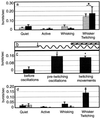Thalamic bursting in rats during different awake behavioral states
- PMID: 11752471
- PMCID: PMC65029
- DOI: 10.1073/pnas.261273898
Thalamic bursting in rats during different awake behavioral states
Abstract
Thalamic neurons have two firing modes: tonic and bursting. It was originally suggested that bursting occurs only during states such as slow-wave sleep, when little or no information is relayed by the thalamus. However, bursting occurs during wakefulness in the visual and somatosensory thalamus, and could theoretically influence sensory processing. Here we used chronically implanted electrodes to record from the ventroposterior medial thalamic nucleus (VPM) and primary somatosensory cortex (SI) of awake, freely moving rats during different behaviors. These behaviors included quiet immobility, exploratory whisking (large-amplitude whisker movements), and whisker twitching (small-amplitude, 7- to 12-Hz whisker movements). We demonstrated that thalamic bursting appeared during the oscillatory activity occurring before whisker twitching movements, and continued throughout the whisker twitching. Further, thalamic bursting occurred during whisker twitching substantially more often than during the other behaviors, and a neuron was most likely to respond to a stimulus if a burst occurred approximately 120 ms before the stimulation. In addition, the amount of cortical area activated was similar to that during whisking. However, when SI was inactivated by muscimol infusion, whisker twitching was never observed. Finally, we used a statistical technique called partial directed coherence to identify the direction of influence of neural activity between VPM and SI, and observed that there was more directional coherence from SI to VPM during whisker twitching than during the other behaviors. Based on these findings, we propose that during whisker twitching, a descending signal from SI triggers thalamic bursting that primes the thalamocortical loop for enhanced signal detection during the whisker twitching behavior.
Figures






Similar articles
-
Behavioral modulation of tactile responses in the rat somatosensory system.J Neurosci. 1999 Sep 1;19(17):7603-16. doi: 10.1523/JNEUROSCI.19-17-07603.1999. J Neurosci. 1999. PMID: 10460266 Free PMC article.
-
Burst and tonic response modes in thalamic neurons during sleep and wakefulness.J Neurophysiol. 2001 Mar;85(3):1107-18. doi: 10.1152/jn.2001.85.3.1107. J Neurophysiol. 2001. PMID: 11247981
-
The effects of tonic locus ceruleus output on sensory-evoked responses of ventral posterior medial thalamic and barrel field cortical neurons in the awake rat.J Neurosci. 2004 Dec 1;24(48):10773-85. doi: 10.1523/JNEUROSCI.1573-04.2004. J Neurosci. 2004. PMID: 15574728 Free PMC article.
-
Thalamocortical [correction of Thalamcortical] optimization of tactile processing according to behavioral state.Nat Neurosci. 2002 Jun;5(6):517-23. doi: 10.1038/nn0602-517. Nat Neurosci. 2002. PMID: 12037519 Review.
-
The role of T-channels in the generation of thalamocortical rhythms.CNS Neurol Disord Drug Targets. 2006 Dec;5(6):571-85. doi: 10.2174/187152706779025526. CNS Neurol Disord Drug Targets. 2006. PMID: 17168743 Review.
Cited by
-
Cross-Whisker Adaptation of Neurons in Layer 2/3 of the Rat Barrel Cortex.Front Syst Neurosci. 2021 Apr 28;15:646563. doi: 10.3389/fnsys.2021.646563. eCollection 2021. Front Syst Neurosci. 2021. PMID: 33994963 Free PMC article.
-
Midline thalamic paraventricular nucleus neurons display diurnal variation in resting membrane potentials, conductances, and firing patterns in vitro.J Neurophysiol. 2012 Apr;107(7):1835-44. doi: 10.1152/jn.00974.2011. Epub 2012 Jan 4. J Neurophysiol. 2012. PMID: 22219029 Free PMC article.
-
Brain State-Dependent Modulation of Thalamic Visual Processing by Cortico-Thalamic Feedback.J Neurosci. 2023 Mar 1;43(9):1540-1554. doi: 10.1523/JNEUROSCI.2124-21.2022. Epub 2023 Jan 18. J Neurosci. 2023. PMID: 36653192 Free PMC article.
-
Urethane anesthesia depresses activities of thalamocortical neurons and alters its response to nociception in terms of dual firing modes.Front Behav Neurosci. 2013 Oct 10;7:141. doi: 10.3389/fnbeh.2013.00141. eCollection 2013. Front Behav Neurosci. 2013. PMID: 24133420 Free PMC article.
-
Cellular and network mechanisms of genetically-determined absence seizures.Thalamus Relat Syst. 2005;3(3):181-203. doi: 10.1017/S1472928807000209. Epub 2007 Jan 22. Thalamus Relat Syst. 2005. PMID: 21909233 Free PMC article.
References
Publication types
MeSH terms
Grants and funding
LinkOut - more resources
Full Text Sources
Other Literature Sources

